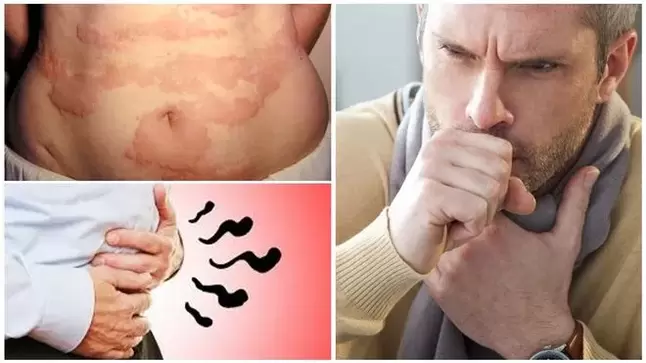Personal hygiene has improved significantly in the last century, but the problem of worms is still important not only for rural residents, but also for urban residents. Statistics make it clear how high the risk of helminth infestations is: every third person on the planet suffers from helminthiasis. But this disease does not always manifest itself clearly, and in some cases, the patient can not correctly interpret the symptoms and remains in the dark for a long time without taking action. Questions about how to understand that you have worms arise both with helminthiasis and other pathologies with similar symptoms.

Worms are an extensive group of parasitic worms, the main signs of their presence in the human body are similar to each other. Doctors believe that every person has been exposed to helminthiasis at least once in their life. In addition, the presence of helminths in the body can cause the development of other diseases, sometimes very dangerous, so the issue of diagnosing this disease is very important.
Mechanisms of infection
Worm infection occurs in four main ways:
- Water, soil or sand. Soil and water provide ideal conditions for storing pest eggs. A person who swims in open water is always in danger of swallowing eggs, which then turn into adults. Not as rare as it may seem, humans also swallow earth particles, exposing themselves to the risk of infection. Some types of parasites can enter the body directly through the skin.
- Food.In the shells of fruits and vegetables that have not been washed or cooked properly, there may be worm eggs. Consumption of raw or lightly processed meat, dried fish, dairy products, etc. associated with no less risk.
- Contact with the patient. Direct contact can occur with both a sick person and an infected animal. Joint activities, living in a common space, close communication contribute to the rapid entry of parasites into the intestines and their further development.
- Bites.Worms can be transmitted by insect bites. This is one of the rarest forms of infection in temperate latitudes, but it can sometimes be the cause of the disease. In hot countries, this trail is more common, which you should remember when you go on vacation in hot countries.
Symptoms
For those who want to learn how to understand that you have worms, they need to understand the principles of recognizing the symptoms. Any symptoms of helminthiasis do not appear immediately after infection, but only when the parasite stops migrating through the gastrointestinal tract and begins to develop into an adult.
Some of the signs are due to the ingestion of toxins released by the worm during its lifetime. All waste enters the intestinal tract, from where it is absorbed into the bloodstream and transported to all organs. There are usually more signs and they are stronger in the case of multiple infection, when the number of worms becomes significant. In people who are immunosuppressed or have other chronic conditions, the symptoms get worse in a relatively short time.

All the signs are divided into two major groups: explicit and implicit. The explicit ones can be evaluated independently at home, while the hidden ones can only be identified in outpatient clinics with the help of appointments for certain examinations and tests.
Clear
The obvious include symptoms that may indicate that there are worms in the body. Their presence does not cause very obvious symptoms, as, for example, happens with the development of viruses. The parasites target life in the body, so excessive deterioration of the infected host's condition would be life threatening. For this reason, the symptoms do not require urgent care.
You may suspect or understand the presence of a helminthic invasion with the following signs:
- Gradual weight loss for no apparent reason, which lasts for several months, and sometimes for several consecutive years. The weight loss rate is not catastrophic, most of the time it is 2-5% per month. With high intensity of infection in people with reduced immunity, this percentage can reach up to 10%.
- Gastrointestinal disorders. Some worms can clog the bile ducts or intestinal tract, causing constant constipation. With high toxin release intensity, on the other hand, recurrent diarrhea may occur. Due to inflammation of the walls of the upper part of the small intestine, there is often increased flatulence and gas formation, while bloating is possible.
- Severe pain in the joints and muscles. Often such manifestations are attributed to the development of joints, but in the case of helminths, this is caused by the migration of parasites. In addition, such pain may be due to the effect of toxins on the joints and muscle tissues.
- Itching near the anus. This phenomenon is caused by the fact that a large number of species of parasitic worms crawl out of the rectum to reproduce and lay eggs. This causes intense itching, which tends to worsen at night and at night.
- allergic manifestations. It often occurs in response to the appearance of a large number of toxins in the blood or due to damage to the intestinal mucosa, which causes an increase in the immune system and an allergic reaction.
- Pulmonary manifestations. Possible in a wide range, ranging from constant coughing and ending with pneumonia. Characteristic for intense ascariasis that occurs in a period of not less than three months from the time of infection.
- Increased temperature. Such an event can be of different intensity. Most of the time, a low temperature of about 37 ° C persists around the clock, but in rare cases fever can occur.

Hidden
The hidden signs can only be revealed by a doctor who will adequately evaluate the clinical picture and will be able to understand that worms may be the possible cause. The preventive measures for the diagnosis of helminthiasis are:
- Fecal analysis for worms. It must be submitted in two stages, therefore, experts do not consider the results of an analysis to be reliable. This is due to the circularity of the reproduction, so it is not always possible to understand from an analysis of the stool that the patient suffers from helminths.
- Clinical blood test. Elevated eosinophil levels indicate that parasites may be present in the body. Often such a hypothesis arises after examinations during treatment or diagnosis of other diseases.
- Antibody analysis. Right now, it is one of the most reliable diagnostic methods that help to understand if a person has worms. Although it is more expensive than similar drugs, recently doctors are increasingly preferring to prescribe it due to its high information content and reliability.

Antiparasitic drugs or laxatives should not be taken before any clinical examination for parasites, as this makes diagnosis difficult.
Signs on a child
In children, the presence of worms is diagnosed more often than in adults. This is facilitated by poor hygiene, close contact with pets or street animals and underdeveloped immune system. A developing organism usually reacts more strongly to the presence of parasites and the consequences may be more global than in adults. But understanding that a child has worms is not easy. The symptoms may be the same as in adults, but most often they are more severe.
In most cases, the signs that indicate helminth infestation in children are:
- Rapid weight loss. With a running image, such an event can lead to a delay in physical growth.
- Hair and nail wear. It occurs due to long-term deficiency of nutrients and vitamins caused by a violation of the absorption of digested food in the intestine.
- Sleep disorder. The pathology can make the child wake up more often at night, crying, spinning and talking in a dream.
- Irritable. Nervous system poisoning and poor health can affect a child's emotional state, cause increased arousal, whimsy, watery tears, etc.
- The desire to constantly scratch the anus. Children do not control external manifestations, so this symptom often helps to understand the cause of diseases and physical changes.

Some parents tend to give their children broad-spectrum antiparasitic drugs for prevention, but experts do not recommend doing so, as most of these drugs are quite difficult to tolerate. It is better to understand first if the child is infected and what kind of treatment is needed, as the treatment of different types of worms is significantly different and is not always effective for helminths of other groups.








































